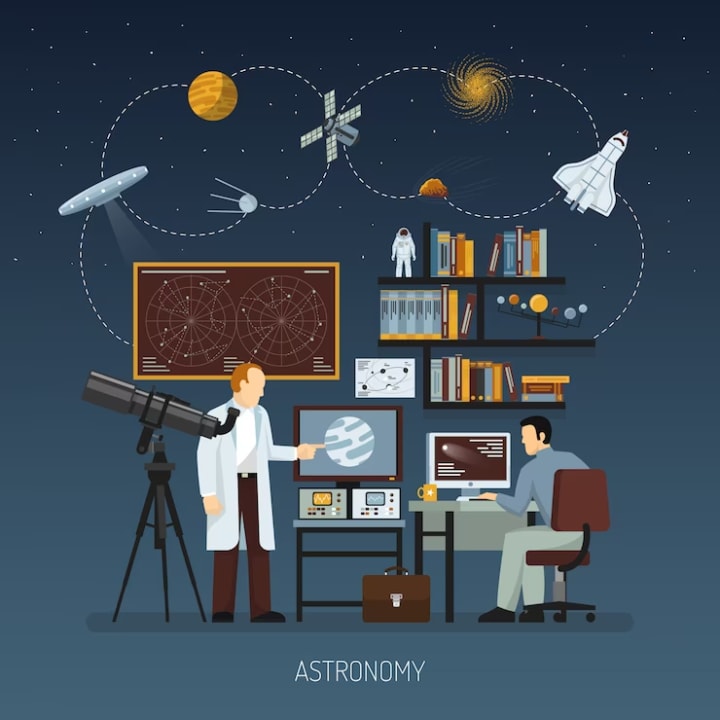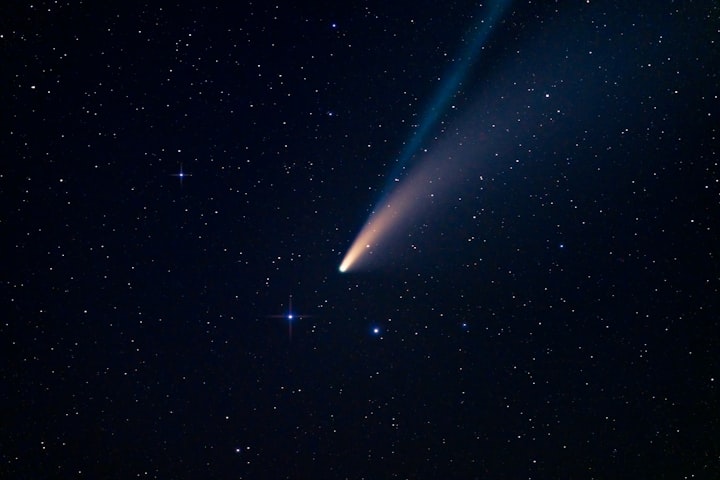I. Introduction

A. Definition of a comet
A comet is a small, icy celestial body that orbits the Sun. It is composed of dust, ice, and gas and is believed to be remnants from the early Solar System. When a comet gets close to the Sun, the heat causes the ice to sublimate, creating a bright coma and a tail that points away from the Sun.
The tail is created as charged particles from the Sun push against the gas and dust in the coma, causing it to stream out into space. Comets are considered to be "dirty snowballs" due to their mixture of ice and dust.
They are of great interest to astronomers as they can provide valuable information about the conditions in the early Solar System and the formation of the planets.
B. Discovery of C/2022 E3 (ZTF)
C/2022 E3 (ZTF) was discovered on March 19, 2022, by the Zwicky Transient Facility (ZTF) located at the Palomar Observatory in California, USA. The ZTF is a state-of-the-art automated survey that scans the sky every night in search of transient astronomical events, such as supernovae, asteroids, and comets.
The discovery of C/2022 E3 (ZTF) was made using the ZTF's wide-field cameras, which capture images of a large area of the sky every few minutes. The images were then processed using specialized software to identify and track the motion of celestial objects, leading to the discovery of the new comet.
The discovery of C/2022 E3 (ZTF) was a significant event for astronomers, as it is one of the brightest comets to be discovered in recent years and has the potential to provide valuable information about the early Solar System and cometary activity.
C. Importance of studying comets
The study of comets is important for several reasons:
Early Solar System: Comets are believed to be remnants from the early Solar System, and their study can provide valuable information about the conditions and processes that led to the formation of the planets.
Origin of water: Comets are thought to have delivered water and other volatile materials to the early Earth, which could have played a role in the development of life.
Astronomical knowledge: The study of comets can contribute to our understanding of the universe, including the formation and evolution of the Solar System and the behavior of celestial bodies.
Climate change: The study of comets can also provide insight into the role that comets and other celestial bodies may have played in past and present climate change on Earth.
Technological advancements: The study of comets requires the use of advanced technologies, including telescopes, spacecraft, and analytical instruments, which can lead to technological advancements and new scientific discoveries.
Overall, the study of comets is important for advancing our understanding of the universe and the processes that have shaped our Solar System and the Earth.
II. Characteristics of C/2022 E3 (ZTF)

A. Orbital path
The orbital path of a comet refers to the path that the comet follows as it orbits the Sun. This path is determined by the gravitational forces acting on the comet, as well as its velocity and direction. The shape of a comet's orbital path is determined by the combination of its distance from the Sun and the strength of the gravitational forces acting on it.
Most comets have highly elliptical orbits, meaning that their distance from the Sun varies greatly as they orbit. This causes comets to spend most of their time far from the Sun, where they are relatively inactive, and then to approach the Sun as they near perihelion, the point in their orbit closest to the Sun. As comets approach the Sun, the heat causes the ice in the comet to sublimate, creating a bright coma and tail.
The exact orbital path of C/2022 E3 (ZTF) is still being studied by astronomers, but it is expected to be highly elliptical, as is typical for comets. The exact shape of the orbital path will be important for determining when and where the comet will be visible from Earth, as well as for understanding its behavior and evolution over time.
B. Size and composition
The size and composition of C/2022 E3 (ZTF) are still being studied by astronomers, but comets in general are small celestial bodies, typically a few kilometers to tens of kilometers in size. They are composed of a mixture of dust, ice, and gas, with the exact proportions varying depending on the specific comet.
Comets are believed to be remnants from the early Solar System, and as such, they are thought to contain valuable information about the conditions and processes that led to the formation of the planets. The composition of comets can provide insight into the composition of the early Solar System, including the presence of water and other volatile materials.
The study of the size and composition of C/2022 E3 (ZTF) will be important for understanding its behavior and evolution, as well as for contributing to our understanding of comets and the early Solar System in general. This will likely involve the use of telescopes and other instruments to observe and analyze the comet, as well as future missions to study comets up close.
C. Visibility from Earth
The visibility of C/2022 E3 (ZTF) from Earth will depend on several factors, including the exact location of the comet in its orbit, its brightness, and the position of the Earth relative to the comet.
At the time of its discovery, C/2022 E3 (ZTF) was located near the Sun and was not visible from Earth. However, as the comet moves away from the Sun and approaches perihelion, its brightness is expected to increase, making it visible from Earth. The exact timing and conditions for viewing the comet from Earth will depend on its orbit and other factors, and will likely be updated as astronomers continue to study the comet.
For best viewing, it is recommended to observe C/2022 E3 (ZTF) from a location with a clear, dark sky away from city lights. A telescope or binoculars may also be helpful for observing the comet. It is important to note that the visibility of comets can be unpredictable, and the brightness of C/2022 E3 (ZTF) may change rapidly as it approaches perihelion and interacts with the Sun.
III. Scientific Significance of C/2022 E3 (ZTF)

A. Insight into the early Solar System
Comets are believed to be remnants from the early Solar System, and as such, they can provide valuable insight into the conditions and processes that led to the formation of the planets and the development of life on Earth.
The study of C/2022 E3 (ZTF) and other comets can also provide information about the formation and evolution of the Solar System as a whole, including the behavior of celestial bodies and the role that comets may have played in shaping the Solar System over time.
Overall, the study of comets, including C/2022 E3 (ZTF), can provide valuable insight into the early Solar System and the processes that shaped our planet and the universe as we know it today.
B. Study of cometary activity
The study of cometary activity involves observing and analyzing the behavior of comets as they interact with the Sun. This includes observing the release of gas and dust from the comet's nucleus, as well as the formation of the coma (the cloud of gas and dust surrounding the nucleus) and the tail.
Cometary activity is driven by the heating of the comet's nucleus as it approaches the Sun, causing the ice in the comet to vaporize and release gas and dust into space. The gas and dust then form the coma and tail, which can be observed from Earth.
The study of cometary activity is important for several reasons. For example, it can provide information about the behavior of comets as they interact with the Sun can also reveal information about the physical processes that drive cometary activity, such as the release of gas and dust from the nucleus and the formation of the coma and tail.
Overall, the study of cometary activity is an important aspect of astronomical research that can provide valuable insight into the nature and behavior of comets, as well as the early Solar System and the universe as a whole.
C. Future observations and studies
Future observations and studies of C/2022 E3 (ZTF) and other comets will likely focus on several key areas, including:
Characterization of the comet's nucleus: This will involve studying the size, shape, and composition of the comet's nucleus, as well as its activity and behavior as it approaches the Sun.
Study of cometary activity: This will involve observing and analyzing the release of gas and dust from the comet's nucleus, as well as the formation of the coma and tail.
Analysis of cometary composition: This will involve studying the chemical composition of the gas and dust released from the comet's nucleus, as well as the chemical composition of the coma and tail.
Search for volatile compounds: This will involve searching for volatile compounds, such as water, in the coma and tail of the comet, which can provide information about the conditions in the early Solar System.
Study of the impact of cometary activity on the Solar System: This will involve studying the impact of cometary activity on the Solar System, including the behavior of other celestial bodies and the role that comets may have played in shaping the Solar System over time.
Overall, future observations and studies of C/2022 E3 (ZTF) and other comets will continue to provide important information about the early Solar System, the conditions necessary for the development of life, and the formation and evolution of the universe as a whole.
IV. Conclusion

Overall, the ongoing fascination with comets and their role in our understanding of the universe is driven by the combination of their historical significance, their potential impact on the development of life, and their ability to provide valuable information about the early Solar System and the universe as a whole.






Comments
There are no comments for this story
Be the first to respond and start the conversation.